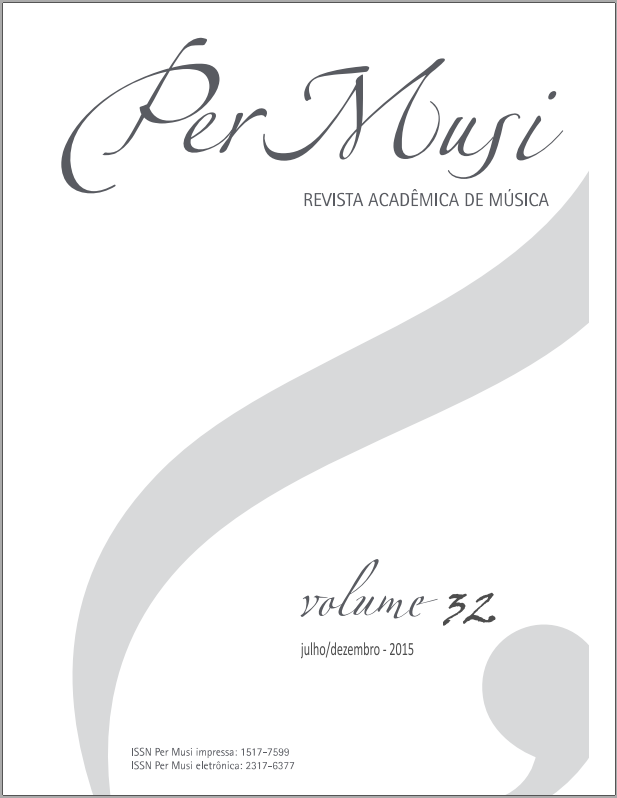Coordenação e controlo de movimentos musicais e desportivos
visão dinâmica da cognição e ação
Palavras-chave:
Música e desporto, Movimento e coordenação motora, Comportamento motorResumo
Este artigo estuda a coordenação e controlo de movimentos desportivos e musicais emergindo essencialmente da ação do executante, da tarefa e do denvolvimento onde esta tem lugar. Para tal, numa visão dinâmica, conclui-se que o cérebro é apenas mais um elemento no controlo deste processo, não tendo nenhum papel hierarquicamente dominante.
Referências
ADAMS, J.A. (1971). “A closed-loop theory of motor learning”. Journal of Motor Behaviour. v.3, n.2, p.111-150.
ARAÚJO, D. (2006). Tomada de decisão no desporto. Lisboa: Edições FMH.
BERNSTEIN, N. (1967). The coordination and regulation of movements. Oxford: Pergamon.
CORREIA, N.; BARREIROS, B.; PASSOS, P. (2013). Comportamento motor e criatividade na aprendizagem da música – o caso do Jazz. In Comportamento motor, controlo e aprendizagem. Ed. Pedro Passos, Lisboa: Edições FMH. p.215-234.
DIAS, G.; MENDES, P.; MENDES, R. (2013). “Modelos explicativos do controlo motor na aprendizagem e treino de movimentos desportivos”. Annals of Research in Sport and Physical Activity. v.4, n.4, p.9-20.
DIAS, G.; COUCEIRO, M.S.; BARREIROS, J.; CLEMENTE, F.; MENDES, R.; MARTINS, F. (2014). “Distance and Slope Constraints: Adaptation and Variability in Golf Putting”. Motor Control. v.18, p.221-243.
ERICSSON, K.A.; LEHMANN, A.C. (1996). “Expert and exceptional performance: Evidence of maximal adaptation to task constraints”. Annual review of psychology. v.47, p.273-305.
ERICSSON, K.A.; SMITH, J. (1991). Toward a general theory of expertise. New York: Cambridge University Press.
ERICSSON, K.A.; KRAMPE, R.T.; TESCH-ROMER, C. (1993). “The role of deliberate practice in the acquisition of expert performance”. American psychological association. v.100, p.363-406.
GODINHO, M., BARREIROS, J.; PEZARAT-CORREIA, P. (1998). Aprendizagem Motora: teorias e modelos. Lisboa: Edições FMH.
JOURDAIN, R. (1998). Música, Cérebro e Êxtase. Rio de Janeiro: Objetiva. 12. LAGE, G.M.; BORÉM, F.; BENDA, R.N.; MORAES, L.C. (2002). “Aprendizagem motora na performance musical: reflexões sobre conceitos e aplicabilidade”. Per Musi: Belo Horizonte. v.5, p.14-37.
LAGE, G.M.; BORÉM, F.; VIEIRA, M.N.; BARREIROS, J. (2007). “Visual and Tactile Information in Double Bass Intonation Control”. Motor Control. v.11, p.151-165.
MAGILL, R.A. (2011). Motor learning and control: concepts and applications. New York: McGraw-Hill. neurociências”. Revista de Neurociências. v.8, n.2, p.70-75.
NEWELL, K. M. (1986). Constraints on the Development of Coordination. In Motor Development in Children: Aspects of Coordination and Control. Ed. M. Wade; H.T.A. Whiting. Dordrecht: Martinus Nijhoff, p.341-360.
NEWELL, K.M.; VAILLANCOURT, D.E. (2001). “Dimensional change in motor learning”. Human Movement Science. v.20, n.4, p.695-715.
OLIVEIRA, M.A.; SHIM, J.K. (2008). “Redundância motora: o problema de graus de liberdade na ciência do movimento humano”. Revista Brasileira de Ciência do Esporte. v. 29, n.2, p.9-25.
PALMER, C. (2006). The nature of memory for music performance skills. In E. Altenmüller, M. Wiesendanger, & J. Kesselring (Ed), Music, motor control and the brain. Oxford, UK: Oxford University Press, pp. 39-53.
PERETZ, I.; ZATORRE, R. (2005). “Brain organization for music processing”. Annual Review of Psychology. v.56, p.90-114.
ROSE, D. (1997). A multilevel approach to the study of motor learning and control. Boston: Allyn & Bacon.
SCHMIDT, R.; WRISBERG, C.A. (2001). Aprendizagem e performance motora: uma abordagem baseada no problema. Porto Alegre: Artmed.
SCHMIDT, R.A. (1975). “A schema theory of discrete motor skill learning”. Psychological Review. v.82, n.4, p.225-260.
TANI, G. (2005). Comportamento motor. Aprendizagem e desenvolvimento. Rio de Janeiro: Guanabara Koogan.
TURVEY, M.T. (1990). “Coordination”. American Psychologist. v.45, n.8, p.938-953. 26. TURVEY, M.T., FITCH, H.L.; TULLER, B. (1982). The Bernstein perspective I: the problems of degree of freedom and context-conditioned variability. In: Kelso JA (ed.). Human motor behavior: an introduction. Hillsdale, NJ: Lawrence Erlbaum Asociates, p.132-143.
ZATSIORSKY, V.M. (1998). Kinematics of Human Motion. Illinois: Human Kinetics Publishers.
Downloads
Publicado
Edição
Seção
Licença
Copyright (c) 2015 Per Musi

Este trabalho está licenciado sob uma licença Creative Commons Attribution 4.0 International License.

Exceto onde está indicado, o conteúdo neste site está sob uma Licença Creative Commons - Atribuição 4.0 Internacional.












